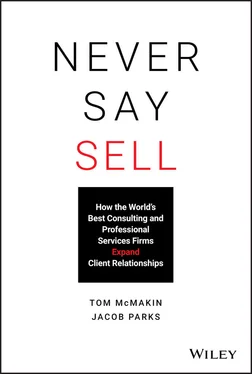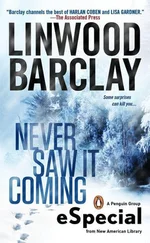Charlie quickly learned it was important to build his brand within the firm. He says, “You need to become known for something. Be the go-to person for the firm on a specific subject and develop a track record of excellent delivery with a handful of partners. As they sell more, they will request you to run their projects, and, over time, they will begin to fold you into the business development process.”
Charlie was being groomed to be a finder . He explains, “The partner's job on a project is to manage the project as a whole and to ensure the client's needs are met. As I worked with several partners, they began to trust me more, and I got more and more responsibility, including exposure to business development.”
Partners would use Charlie to help prepare decks, do research on a proposed project, and join them in presenting to clients. He wasn't expected to drive business development, yet, so much as to absorb what he saw by osmosis.
Charlie recalls, “Working on a proposal with a partner led to me being staffed on that project. I was absolutely incentivized to do a good job on the proposal, but I was not incentivized or rewarded if that proposal turned into a sale. That went to the partner.”
Charlie left Deloitte before taking the next step – a promotion to senior manager, deciding instead to co-found Capstone Event Group, a firm that manages running races (Capstone just added San Francisco's Bay to Breakers franchise to their growing stable). As Charlie describes it, his firm “has been able to give some really special community events a long-term home by acquiring them and managing them effectively.”
If Charlie had stayed at Deloitte, he would have likely, over time, moved into a finder role. He expands,
As a senior manager, I would have begun to have goals that were tied directly to sales. A senior manager is, essentially, a partner-in-training. That's when it starts to shift, and Deloitte takes a person who has historically been rewarded and promoted based on analytics and then on their ability to manage, to a place where they are rewarded for new business. It is a slow ramp, but eventually you get to try and win new business, which is the road to being partner; and once you are a partner, of course, business development is what it's all about.
I think the core message Deloitte tried to send, culturally, was that partners want to help bring people along. You were never just given a sales goal. To the contrary, with fewer senior people, the message was do good work, establish strong relationships, and over time you will get pulled into the sales process.
Call this the “partner's imperative.” If you want to drink from the cool, clear waters of profit participation in an expert services firm, you have to be prepared to make it rain. Both Deloitte and Charlie were clear about this from the start.
Firms often struggle with how to bring up junior partners. “I worry about where our next generation of rainmakers will come from,” says a partner at a leading HR consultancy.
There are a variety of training programs and distinct steps that firms employ to prepare their newer hires to one day land and expand work on their own. Ashley Horne at Womble Bond Dickinson describes her law firm's learning and development program. “We provide a lot of training and upskilling for our attorneys. We have a Leadership Womble program that's directed at our partners. It allows them to get a kind of mini-MBA in which they really dig into a business development issue the firm is grappling with and help develop solutions. We also have a Getting to Equity program for counsel where they learn about relationship management, how to look for triggering issues that are good from a BD perspective, and how to drive the growth of their books of business. They meet with various sides of our firm (both operationally and Client Development – focused) to better inform their efforts.”
That said, although some firms have a curriculum and “universities” focused on helping senior managers make this leap to becoming a “finder,” the rule is still that most young professionals learn business development by osmosis with partners proactively deciding to bring someone along in apprenticeship – not by structured or systematic training.
They surely didn't learn it at their professional schools. Says Cole Silver, chief client officer at Blank Rome, “Law schools are missing the boat. You know, they teach us how to be really good lawyers and tacticians, but they don't really teach us anything about the business of law, about getting clients, about managing other lawyers, or about taking care of clients in a service-oriented way. I even, actually, approached the dean of the law school once to teach a class on marketing and business development for the law school, and they said, ‘Well, we can't get accreditation through the ABA, so we can't do it.'”
Leading firms often try to combine the best of both worlds, creating structured programs that bring high potential professionals together in a peer-learning setting and rotate them between accomplished partners to give the future finders exposure to a variety of rainmaking styles, and a culture of best practices emerges, where these managers share their lessons and various approaches with one another.
Firms ignore this kind of intentional training at their peril. As Trey Cox, partner at Gibson, Dunn & Crutcher, says, “[We] went to law school. We spent our time there learning the law. No one taught us this stuff. It is neither natural nor instinctive.”
The partner's imperative takes two forms. You can bring in new work from companies with whom your firm has never worked before or you can increase the amount of work you are doing for a current client. In many ways this latter form of growth is the bigger opportunity even if it is a challenge.
It's a fall day. Crisp as hard cider. Reds, yellows, greens, and chocolate browns paint the oaks and elms. We walk up to the front entrance of one of America's most storied technology and business consulting firms. They put a man on the moon, invented the ATM, and designed an artificial intelligence program that rivals Ken Jennings at Jeopardy ! A part of global business life for more than 100 years, no one in corporate America ever got in trouble for hiring them.
We have an appointment with the head of strategy for one of the company's business units.
“What's the secret to driving business development with current clients?” we ask over espressos in the ground floor café. We elaborate, “Your sales force is legendary, and you're known for your quality. Is that the magic combo?”
“You'd think so,” our host says, the wind rustling the tops of the trees out past an expansive lawn, “but here's the thing: We ran an analysis on two of our business units. We found that the lion's share of the revenues and profits in each business came from a concentrated core of customers. It was the Pareto Principle at work. On either side of the house, 80% of our business came from 20% of our clients.”
“We see that in a lot of firms.” We say, “The relationship between client numbers and revenues is inversely related.”
A slight man with a calm intelligence, our host continues,
We're not alone. A lot of firms segment their clients in this way. They'll call their most productive clients “Diamonds” or “Platinum Accounts” or something similar. Here's what's interesting: When we compared the 80/20 list in the two business units, we only found a 10% overlap in our biggest clients. Imagine! We do hundreds of millions of dollars in consulting work with a Silicon Valley software company and sell them no technology while we outfit a global pharmaceutical distribution company with technology but do no services work with them. It's like the practice leads on either side of the house live on different planets.
Читать дальше












